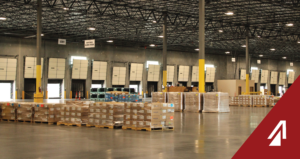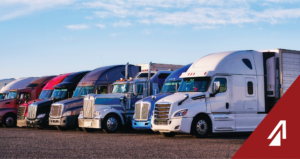2019 is in full swing and the current logistics trends are being established. This year, the trends fall into 6 major categories: Trucking, Technology, Six Sigma, Regulation, Sustainability, and Global Trade. Here are the top logistics trends for each category in 2019.
Trucking
Trucking is where the rubber meets the road for logistics. These trends involve drivers, carriers, and shippers – new developments and big concerns. According to the American Trucking Association (ATA) and American Transportation Research Institute (ATRI) these are the top trucking concerns and trends for 2019.
Driver Shortages – This is nothing new. The trucking industry has seen a decline in drivers for several years, and 2019 is no exception. The most concerning aspects of this trend, though, are that there are fewer drivers replacing the ones retiring or leaving the industry. The average age of over-the-road CMV drivers is 49 years old – approximately 10 years away from typical retirement age. But, the ATA says with the sprawling economy and e-commerce boost, as many as 890,000 drivers will be needed by then. Current solutions to the driver shortage crisis are the DRIVE-Safe Act, the FAST Act, and other Hours of Service reforms.
Hours-of-Service – The second greatest concern, according to the ATA and ATRI, Hours-of-Service (HOS) legislation has received serious scrutiny from all sides due to both its serious nature and the impact it has on CMV drivers and other motorists sharing the road. Current law states that drivers may only operate a truck fourteen hours a day with eleven hours of drive time, and must take a mandatory ten hour rest break. The trending controversy is a push by the ATA and others to persuade the US Department of Transportation to amend the law to allow a broken up rest period of six and four hours rather than ten consecutive hours. That way, drivers could take advantage of less congested traffic periods and rest as needed.
Technology
The technology trend is expected to significantly relieve pressure built by the growing e-commerce economy of 2019. More often, customers are looking for easier ordering, quicker delivery, and more secure transactions. These technology trends are sure to improve the customer experience as well as relieve strain on the understaffed logistics workforce.
Digital Supply Chain – In 2019, more supply chains will be going digital with superior central control towers (transportation management systems, data collection, analysis, etc.), EDI/API, and industrial IoT. Companies are making it easier for their customers to order products, and logistics service providers are making it easier to ship them. Modern TMSs offer better visibility to customers, richer idea and improvement streams, real time metrics prompting faster decision making, and round the clock access to shipment scheduling, location, and progress.
Another shipping trend is greater data transmission with EDI/API. More companies are implementing EDI/API technology to transmit information automatically and remove the distortion of human interaction. Information like shipment data or documents are transferred more quickly and more reliably than ever before.
Industrial IoT is creating better visibility as well. Workers can either manually use their devices to input or update data (e.g. dock workers using handheld devices to scan labels and confirm the correct freight before shipping) or automatically update the database as needed (e.g. drivers updating their current location via cell phone). One of the best features is that, with internet enabled devices, these can work nearly anywhere at any time. This gives the customer superior visibility and control.
Blockchain– A popular trend in finance as well as logistics in 2019. Blockchain is the new method for sharing and storing data securely across a network of computers rather than on a single server. Data is more protected and much more difficult to infiltrate and manipulate. Customers are able to able to audit their purchase orders and invoices with confidence knowing that the information provided is correct.
Six Sigma
Lean management and Six Sigma principles have been around for much of the 20th century, but with greater economic demands in 2019, these trends are stronger than ever. More companies are looking for ways to save money, reduce storage space, and eliminate wastefulness in their businesses.
Lean Management – in 2019, wasteful companies fall by the wayside and fast efficient companies succeed. Lean management principles help companies:
• Find what products or services are most valuable to their customers
• Find those products or services’ life cycles to make them more valuable to the customers
• Determine if resources are being wasted with those products or services
• Establish pull from their customers
• Eliminate all causes for defects or sub-par quality from the manufacturing or shipping process
Once a company knows what its customers want the most and what is most valuable to them, it can eliminate anything that is not valuable or useful. It can save time and money, free up space in its warehouses, focus on perfecting its core competencies, and create a competitive advantage in the marketplace.
Six Sigma – This is a trend geared for problem solving and removing defects in systems. More companies are partnering with Quality professionals (ASQ, black belts, green belts, etc.) to find areas in their company that require improvement and find solutions for improvement. These professionals will form teams for well-defined projects and focus on methods like process gridwalks, DMAIC method, and 5-Whys.
Regulation
Regulations are a hot-button trend, frequently sparking controversy. They are constantly changing and it is vital for supply chain managers, carriers, and other logistics service providers to be aware of them. In 2019, some of the most prevalent regulation trends involve the ELD mandate and minimum CMV driver age requirements.
ELDs – The electronic logging device mandate was first mentioned in late 2015 giving drivers until 2019 to fully implement them. The logs automatically record drive time and make it easier for state police and others to enforce HOS laws. The mandate has been called controversial by many and has resulted in greater numbers of drivers fleeing the workforce. Trucking groups like the ATA and ATRI are studying the effects of the mandate and will submit their finding to the FMCSA and USDOT for review.
Minimum Age Rules – One strategy to combat driver shortages is the DRIVE-Safe Act proposed by Representative Duncan Hunter (R-CA) in the House of Representatives and Senator Todd Young (R-IN). The act would allow CDL holders, aged 18-20 to drive interstate after completing an apprenticeship program. Currently these younger drivers are permitted to drive intrastate but not cross state lines. Opening the market to these drivers would allow more workers into the labor force and allow them to begin with a driving career, rather than try and persuade them to it later. The bills are currently in committee in Congress and are expected to be voted on later this year.
Sustainability
One of the top consumer concerns in 2019 is the sustainability of their products. Customers, now, not only want sustainable products, but sustainably sourced products. This means more supply chains are going green and looking for smarter options to bring their products to market. Some popular trends of 2019 include liquid natural gas vehicles and sustainable warehousing.
Liquid Natural Gas Vehicles – This year, larger fleets like UPS and others are looking to liquid natural gas and other, more carbon neutral fuels to power their trucks. Liquid natural gas in engines like Cummins Westport ISX12N are capable of producing 90% fewer carbon emissions than permissible by the EPA. Natural gas is cheap and easy to harness as well, making it an ideal candidate for replacing traditional diesel trucks. Currently, there are approximately 130,000 natural gas vehicles on the road, but companies like Clean Energy and others are looking to expand that number by assisting in financing natural gas vehicle purchases and building more natural gas filling stations nationwide.
Sustainable Warehousing– More environmentally conscious consumers are purchasing products from sustainably sourced supply chains – including warehouses. Companies are looking for spaces that meet with LEED compliance:
• Location and transportation – Warehouses close to major cities or the final customer. Also ones that have systems like public transit available for workers.
• Sustainable site – Areas that do not harm the local environment as well as buildings constructed that are smarter, greener, and more energy efficient.
• Water Efficient – Efficient water consumption and landscape irrigation.
• Energy and Atmosphere – Building/machine electricity usage and climate within the building itself.
• Materials and resources – Building materials as well as product inputs. These must be responsibly sourced products and have recyclable applications for the waste.
• Indoor Environmental Quality – A comfortable work environment for the employees – light, air conditioning, etc.
Global Trade
The big global trade trends of 2019 revolve around tariffs and US Congress ratifying the USMCA trade deal.
Tariffs – Since September 2018, the US has imposed a 10 percent tariff on $200 billion of Chinese goods and is expected to extend that to 25 percent in April. President Trump is meeting with Chinese President Xi and hopes to make a deal, making the tariff jump unnecessary. “We believe that trade must be fair and reciprocal. The United States will not be taken advantage of any longer,” President Trump said in an early February statement. The nation will be watching to see if these tariffs will cause a trade war or level the playing field.
USMCA – In 2018, the United States, Mexico, and Canada agreed to a new North American trade deal to replace NAFTA, the USMCA deal. Despite negotiators agreeing to terms, the US Constitution states the President may agree to treaties only with the consent of Congress. So, despite US Trade Representative, Robert Lighthizer, achieving agreement with Mexico and Canada, Congress will now need to vote to approve or reject the USMCA. The vote is expected to take place in April, but is still being debated in committee at the time of this writing. So, it remains to be seen if it will be voted on this year. Either way, it is a trend to watch in 2019.
These are the trends that we feel are the ones to watch in 2019. Do you agree? Let us know in the comments below.



